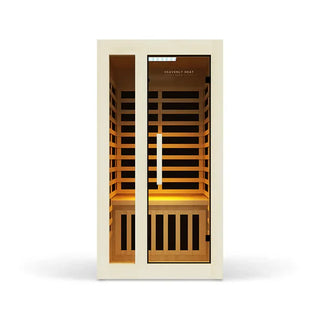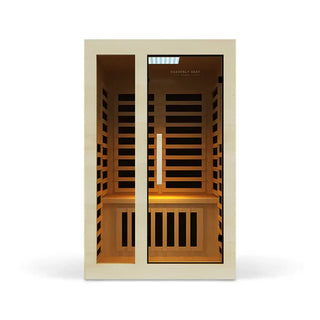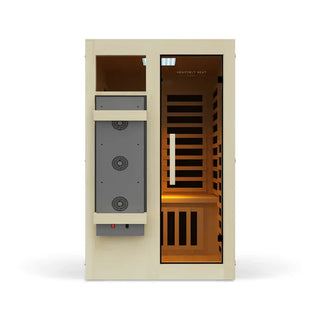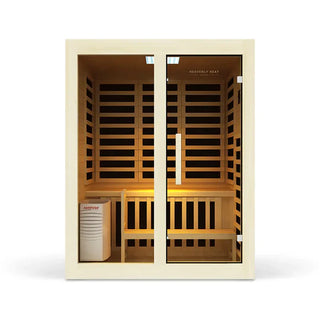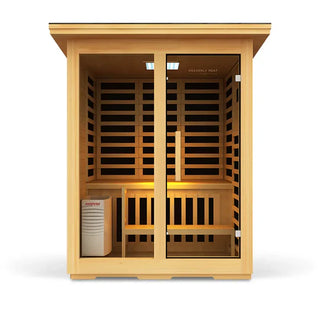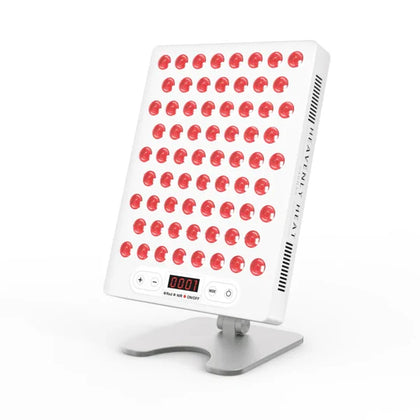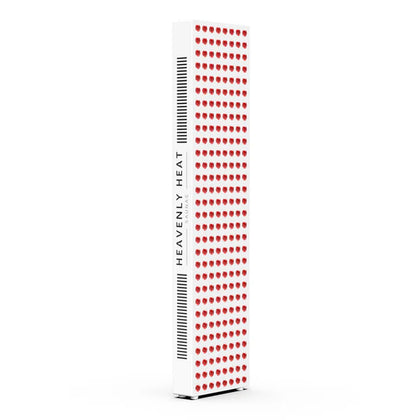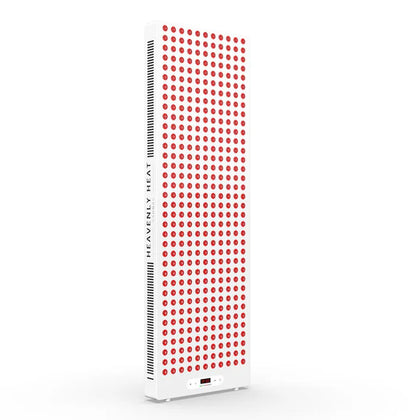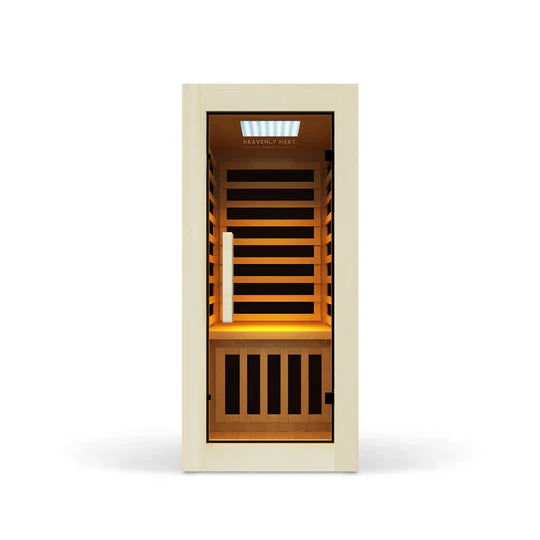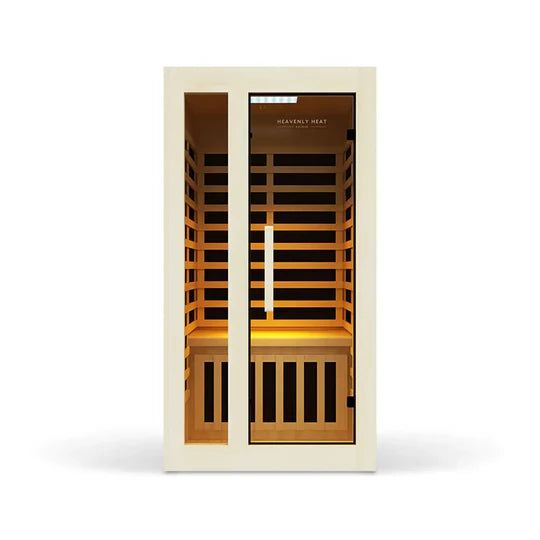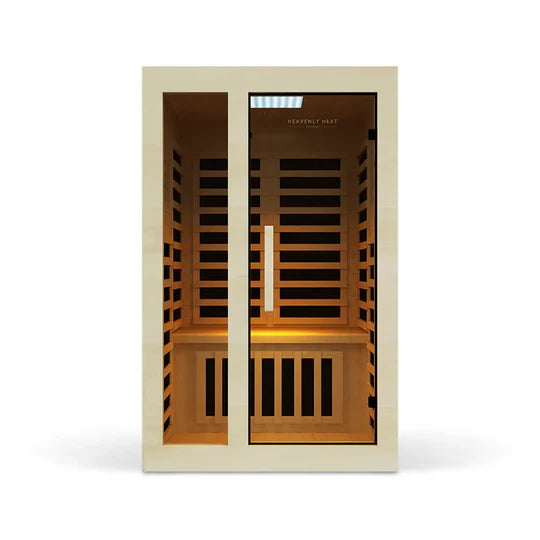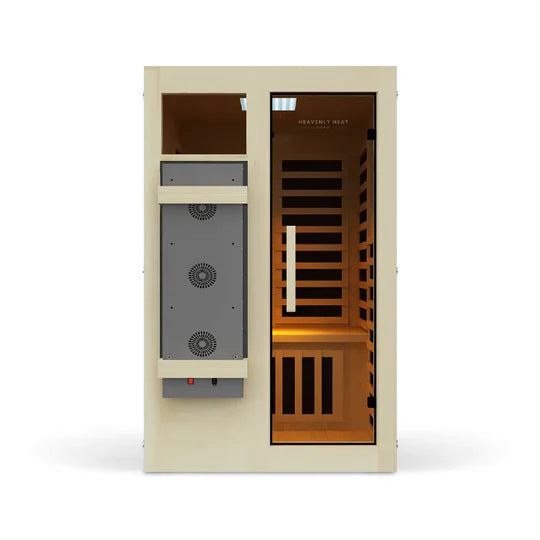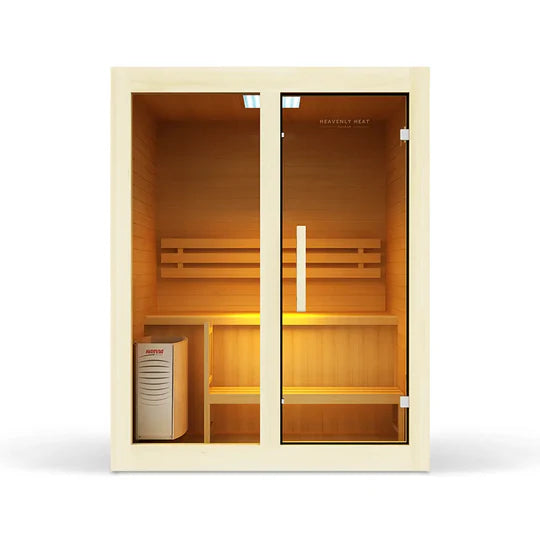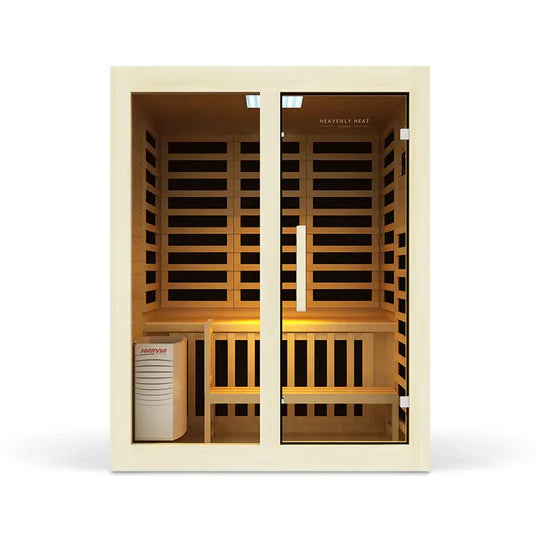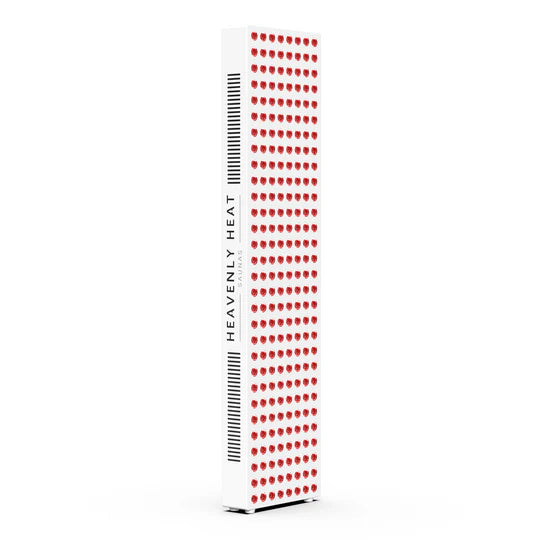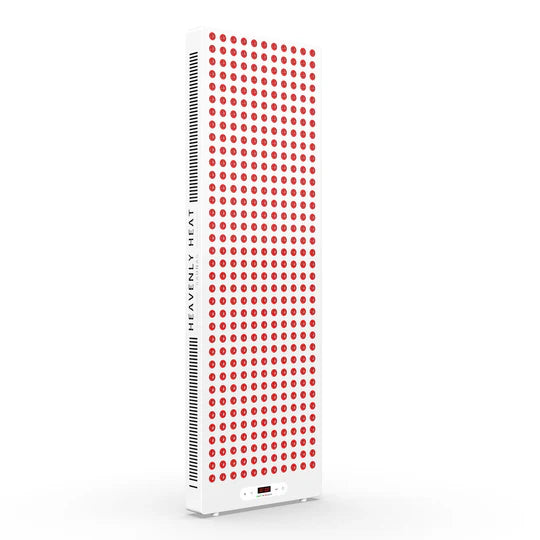Maximize Sauna Benefits: Tips for Health, Detox & Relaxation

Table of contents
Many people sit in a sauna, expecting magic, only to walk out feeling underwhelmed.
Without the right approach, you might be missing out on its full potential like faster recovery, glowing skin, and deep relaxation.
The good news? With a few simple tweaks, you can unlock all the amazing benefits. Let’s dive in!

Key Takeaways
Prepare Before Your Session: Eat a light meal, stay hydrated, and consider a cold shower.
Set the Right Heat & Time: Start with 10–15 minutes at 150–170°F and adjust as needed.
Stay Hydrated: Drink water before, during, and after to replace lost fluids.
Use Cooling Breaks: Step outside or take a cold shower to regulate body temperature.
Enhance Recovery: Stretch, moisturize, and replenish electrolytes post-sauna.
Why Should You Use a Sauna?
- Using a sauna often helps you feel healthier overall: A sauna is more than just heat, regular use can support your general well-being and daily energy levels.
- Saunas help your heart stay strong and your blood flow better: A Study found that , When you sit in a sauna regularly, it helps your circulation and may even lower your blood pressure over time.
- After workouts, saunas relax your muscles and speed up recovery: The deep heat increases blood flow, easing tightness and helping your body recover faster after exercise or physical strain.
- Long-term sauna use may protect your brain and heart from diseases: According to research , regular sauna sessions may lower your risk of heart problems and brain-related conditions as you age.
- Wearing the wrong clothes or eating too much can ruin your session: To stay safe and comfortable, avoid synthetic clothing and heavy meals before stepping into the sauna.
- Breathing gets easier and your body fights illness better with regular sessions: Saunas can help with lung health, strengthen your immune system, and ease symptoms of colds, arthritis , and more.
- Sweating in a sauna helps your body get rid of harmful toxins: As you sweat, your body naturally pushes out waste, helping you feel refreshed and more balanced.
- The calming heat melts away stress and helps you sleep better: Saunas are a great way to relax deeply, reduce anxiety, and enjoy better sleep at night.
Best Tips for an Effective Sauna Session
Prepare Your Body Before Entering
- Eating something light helps your body feel better inside the sauna: Before stepping into the heat, eat a small meal with light, easy-to-digest foods like fruits, yogurt, or a handful of nuts. Avoid heavy or spicy meals, they can upset your stomach and make the session uncomfortable.
- Drinking water ahead of time keeps you from feeling weak or dizzy: Have 16–20 ounces of water at least an hour before your session. Going in well-hydrated helps you avoid tiredness, headaches, and that drained feeling during or after the sauna.
- Avoiding sugary or caffeine drinks makes it easier to relax: Stay away from soda, energy drinks, or too much coffee before your sauna. They can mess with your ability to relax and may leave you feeling jittery or restless.
- A cold shower before stepping in makes the heat feel better: Rinse off with cold water just before your session. It helps your body handle the sauna heat more easily and makes the whole experience feel fresher and more enjoyable.
Set the Right Temperature and Duration
- Beginners feel more comfortable when the heat is not too high: For anyone new to saunas, setting the temperature between 150°F and 170°F helps the body ease into the heat without feeling too intense.
- Experienced users enjoy the heat when it’s turned up a bit more: Those who are used to saunas often go for temperatures around 180°F , which brings more relaxation and deeper sweating .
- Starting with short sessions helps your body get used to it: New users should begin with just 5 to 10 minutes . It gives the body time to adjust and lowers the risk of overheating.
- Staying longer works better once your body is used to the heat: If you're used to the sauna, you can enjoy 20 to 30 minutes safely, but only if your body can handle it .
- Most people feel best with a session between 15 to 20 minutes: For many, 15 to 20 minutes is the sweet spot. It’s long enough to get the benefits, but short enough to avoid strain.
- Overdoing it can leave you dehydrated and tired: Staying in too long can lead to dehydration , so it’s important to listen to your body and leave the sauna if you feel uncomfortable.
Stay Hydrated During and After
- Drinking water before the sauna helps your body handle the heat: Having a glass of water before you step into the sauna gets your body ready for the sweat and keeps you from feeling drained too quickly.
- Taking small sips during breaks keeps you from drying out: Instead of waiting till you're thirsty, sipping water during sauna breaks keeps your body safely hydrated and avoids sudden fatigue.
- Feeling dizzy or dry means your body is running low on water: If you notice signs like dizziness, dry mouth, or dark urine, it means dehydration is kicking in and you need to drink up fast.
- Drinking coconut water or herbal tea after helps bring your body back: After the sauna, your body needs more than just water, hydrating with coconut water or tea helps replace the minerals you lost through sweat.
- Eating juicy fruits like watermelon adds to your hydration: Adding water-rich fruits or veggies like cucumbers or watermelon boosts your recovery and makes you feel fresh and energetic again.

Use Proper Sauna Etiquette
- Taking a shower before entering shows respect for others: Washing off dirt, sweat, and skincare products keeps the sauna clean and helps your body handle the heat better. It's a small effort that makes a big difference for everyone.
- Sitting on a towel keeps the benches clean for the next person: Using a towel under you stops sweat from soaking into the wood, which helps maintain hygiene and comfort for everyone who uses the sauna after you.
- Giving others space makes the sauna more relaxing for all: Being mindful of personal space helps everyone enjoy their time. Don’t crowd others, let people have their own breathing room to fully relax.
- Matching the room’s mood keeps the experience peaceful: Some people like silence, others may chat softly. Pay attention to the vibe and follow it, it’s part of showing good sauna manners.
- Leaving quietly shows consideration for those still inside: When exiting the sauna, try not to bang the door or make noise. A quiet exit lets others continue relaxing without disruption.
Incorporate Cooling Breaks
- Taking cooling breaks keeps your body temperature under control: Cooling off between sauna sessions stops you from getting too hot and helps your blood flow better.
- Short breaks every 10–15 minutes help you enjoy the sauna longer: If you step out for a quick break every 10 to 15 minutes, you won’t overheat and you’ll feel better overall.
- Fresh air or cold water cools you down fast: Some people like to step outside, others prefer a cold shower or a plunge in cold water, all great ways to cool the body quickly.
- A quick rinse before going back in makes you feel fresh again: Showering before re-entering the sauna isn't just clean, it's a fast way to feel ready for more heat.
- Cold water boosts energy and improves blood flow: Dipping in cold water wakes up your body, improves circulation, and gives you a quick energy boost.
- I used to avoid breaks, but now I know they help: I used to think longer sessions were better, but after copying experienced users, I learned that cooling breaks make a big difference.
- Cooling off helps your body reset and makes the sauna more enjoyable: No matter how you cool down, taking a break helps your body handle the heat better and makes the whole experience more relaxing.

Enhance the Experience with Aromatherapy & Stretching
- Aromatherapy makes the sauna feel more relaxing and refreshing: Aromatherapy takes your sauna session to the next level. Scents like eucalyptus, tea tree, and rosemary calm the mind and help open up your breathing, making each moment feel lighter and more soothing.
- Adding oils to the steam spreads the scent naturally: A few drops of essential oils in water, poured over sauna rocks, release the scent through steam, letting you enjoy the aroma without overpowering the space.
- Stretching before and after makes your body feel more open and relaxed: Gentle stretching around your sauna session helps loosen tight muscles and improves how your body feels, so you step out feeling calm, flexible, and refreshed.
Post-Sauna Recovery and Skincare
- Taking a cold or cool shower helps your body recover safely: Cooling down after a sauna is essential. A lukewarm or cold shower helps the body gradually return to its normal temperature and prevents overheating after the heat session.
- Switching between hot and cold water wakes up your circulation: Some people like to alternate between heat and cold water. This back-and-forth helps boost blood flow and leaves the body feeling refreshed and recharged.
- Eating something light helps your body get back the lost energy: Replenishing lost nutrients with a small snack, like bananas or nuts, helps your body recover and gives it the fuel it needs after sweating in the sauna.
- Sauna opens up your skin and helps it breathe better: The heat from the sauna opens your pores and helps your skin release toxins. This is good for cleansing, but it also means your skin needs some extra care afterward.
- Washing off the sweat keeps your skin from breaking out: For people with oily or acne -prone skin, the sauna can help clean out pores. But if the sweat isn’t washed off properly, it can lead to pimples or clogged skin.
- Moisturizing after shower keeps your skin soft and safe: After your post-sauna shower, applying a gentle moisturizer is important, especially if you have dry or sensitive skin. It helps keep your skin hydrated and protected from dryness or irritation.
How to Add Saunas to Your Wellness Routine?
Choose the Right Type of Sauna
- Traditional saunas heat the air to make you sweat a lot: Traditional saunas use hot stones to warm up the room, creating dry heat. This heat makes you sweat heavily, which can help remove toxins and relax your body.
- Infrared saunas warm your body without making the room too hot: Infrared saunas use light waves that go directly into your skin. The room stays cooler, but your body still gets deeply heated, which can soothe muscles and joints.
- Steam saunas fill the room with moisture to help you breathe better: Steam saunas create a hot and humid environment. This can be great for your lungs and may ease breathing problems or help clear out your chest.
- Hybrid saunas mix different styles so you can get the best of everything: Hybrid saunas combine methods like traditional heat and infrared. This lets you enjoy a more personalized sauna session with multiple benefits in one.
Start with Short Sessions
Jumping into long sauna sessions right away can be overwhelming for the body.
Beginners should start with 10 to 15-minute sessions to allow their bodies to adapt to the heat.
Over time, you can gradually increase your duration. Staying in too long can lead to dehydration or dizziness, so pacing yourself ensures a sustainable practice.
Hydrate Before and After
Proper hydration is key to a safe sauna experience. Drink water before entering to prepare your body for increased sweating.
Post-session, replenish lost fluids with electrolyte-rich options like coconut water or naturally infused electrolyte drinks that help restore minerals without unnecessary sugars.
Staying hydrated keeps you feeling refreshed and prevents issues like dizziness or dry mouth, so choose drinks that support recovery and balance.
Incorporate Sauna Into Your Routine
- Start with Smart Hydration Choices: Maximize your sauna sessions by hydrating the right way, ditch plastic and go for a glass water bottle with added electrolytes for better absorption and fewer toxins.
- Daytime Sessions Work Best: Scheduling your sauna time earlier in the day is ideal; evening infrared sessions can spike cortisol and interfere with your sleep cycle.
- Consistency Brings Long-Term Gains: “ Aim for 20-minute sessions, 4–7 times per week, at about 174°F (79°C) to get serious benefits like cardiovascular support and protection against neurodegeneration,”says Dr. Janine Bowring , ND, a naturopathic doctor specializing in holistic wellness.
- Mindful Routine Equals Better Results: Whether you choose morning, midday, or evening, pick a consistent time that suits your lifestyle and helps you feel more energized, focused, or relaxed.
- Stick to a Safe Weekly Rhythm: 3–4 sauna sessions a week work well for most people, but daily use is safe too, just stay in tune with how your body responds.
Pair Sauna Sessions with Cold Therapy
Alternating between heat and cold offers powerful health benefits. Sauna use increases circulation, while cold therapy reduces inflammation and speeds up recovery.
Stepping from the sauna into a cold shower for 30-60 seconds enhances the benefits.
Contrast therapy improves cardiovascular health and strengthens the nervous system.
Listen to Your Body
Your body provides clear signals about when and how to use a sauna. If you feel dizzy, lightheaded, or excessively fatigued, exit and cool down.
Sauna sessions should be adjusted based on how you feel each day. If you’re unwell, it’s best to skip the sauna until fully recovered.
Follow Proper Post-Sauna Care
- Let your body cool down slowly before a cold shower: Give your heart time to calm down naturally to avoid shock after the sauna.
- Drink water or electrolyte drinks right after sauna: Replenishing fluids immediately keeps your body balanced and healthy.
- Stretch muscles after sauna to feel less stiff: Heat makes your muscles relaxed and ready for gentle stretching to recover better.
- Cooling down well helps you get more benefits: Proper cooling after sauna keeps you relaxed and supports detox or recovery.
- Following these steps leaves you refreshed and energized: Good post-sauna care makes sure you feel great and enjoy lasting effects.
Should You Combine Sauna & Cold Therapy?
- Using Heat and Cold Together Helps Your Body Recover Faster: Switching between the heat of a sauna and the shock of cold therapy can supercharge your body’s recovery and resilience. Heat opens up your blood vessels to improve blood flow, while cold tightens them to clear out waste and reduce swelling.
- Going Back and Forth Between Hot and Cold Boosts Your Immunity: Moving between hot and cold treatments strengthens your immune system, helping you stay healthier. Athletes use this method for quicker muscle healing, but anyone can get benefits from it.
- Starting Slowly Helps Your Body Adjust to Temperature Changes: Begin with gentle exposure to avoid feeling dizzy from sudden heat or cold. The cold can be tough at first, but over time it teaches your body to handle stress better and increases your endurance.
- Trying Sauna and Cold Therapy Together Can Help You Improve: When you combine sauna and cold therapy, it challenges your body and builds strength. Give it a try to feel the benefits yourself!
How to Recover and Cool Down After a Sauna?
Hydrate Properly to Replenish Lost Fluids
After sweating in a sauna, rehydration is key. Drink at least two to three glasses of water immediately after your session. Coconut water and herbal teas provide hydration while offering additional nutrients.
Take a Cool Shower or Bath for Temperature Regulation
A refreshing shower helps lower body temperature and promotes circulation. Cool water is best—around 60-70°F—to bring down your core temperature gradually. Some prefer an ice bath, but lukewarm water also provides relief.
Rest and Allow Your Body to Normalize
Give yourself a few minutes to unwind after stepping out of the sauna. Sitting or lying down lets your body gradually return to normal temperature and heart rate. Typically, 10-15 minutes of relaxation is enough.
Consume Electrolyte-Rich Foods and Drinks
Electrolytes help restore balance after a sauna session. Bananas, oranges, avocados, and leafy greens are excellent natural sources. Coconut water replenishes electrolytes quickly.
Practice Deep Breathing for Relaxation and Recovery
Deep, slow breaths regulate heart rate and enhance oxygen flow, promoting faster recovery.
Breathing at a steady, natural rhythm, especially at a resonance frequency, helps increase heart rate variability, ease stress, and improve adaptability after a sauna session. Practicing mindful breathing for five to ten minutes enhances circulation.
Stretch Gently to Soothe Muscles and Joints
Your muscles are warm and pliable after a sauna, making it a great time for light stretching. Gentle static stretches improve flexibility and relieve tension.
Avoid Alcohol and Heavy Meals Post-Sauna
Drinking alcohol after a sauna dehydrates your body further. Similarly, eating heavy meals right after a sauna can strain digestion. Opt for lighter options like a smoothie, fruit, or a protein-rich snack.
How to Track Your Progress and Benefits from Sauna Use?
- Your Heart Rate Shows Your Sauna Progress: Check your heart rate before and after each session to see how your heart gets stronger over time.
- Better Sleep Comes with Regular Sauna Use: Using a sleep app helps you notice if you fall asleep faster and wake up feeling refreshed after sauna sessions.
- Weigh Yourself to Stay Properly Hydrated: Weighing yourself before and after sauna time helps you track how much water you lose and remind you to drink enough.
- Clearer Skin Means Sauna is Working: If your skin looks more hydrated and clear, that’s a sign your sauna sessions are helping your skin.
- Sweating More Means Your Body is Adjusting: If you start sweating faster and handle hotter temperatures better, your body is getting used to the sauna heat.
- Use Apps and Journals to Track All These Benefits: Fitness trackers, smartwatches, or simple journals make it easy to watch your progress and stay motivated.
FAQs
What’s the Best Time of Day to Use a Sauna for Maximum Benefits?
The best time to use a sauna depends on your goals. A morning session boosts energy, circulation, and metabolism, aiding weight loss. An evening session promotes relaxation, muscle recovery, and better sleep. Using a sauna after a workout enhances recovery, while consistency maximizes long-term benefits. Choose a time that fits your routine for the best results.
Can Sauna Use Help with Mental Clarity and Focus?
Sauna sessions enhance mental clarity and focus by increasing blood flow to the brain, delivering oxygen and nutrients that sharpen cognitive function. Sweating reduces stress and brain fog, while deep relaxation lowers cortisol levels, promoting calmness and focus. Endorphins boost mood and alertness, making concentration easier. Regular sauna use strengthens cognitive performance, keeping the mind sharp and energized.
How Can You Prevent Dizziness or Lightheadedness in the Sauna?
Stay hydrated to prevent dizziness in the sauna. Drink water before and after, and add electrolytes if sweating heavily. Eat a light meal an hour before to avoid lightheadedness. Start with 10–15 minute sessions, increasing gradually. Take breaks to cool down. If you feel faint, leave immediately and rest in a cool space.
Are There Any Unexpected Signs That You’ve Spent Too Long in the Sauna?
Spending too long in the sauna can have unexpected effects. You might feel drowsy, a sign your body is struggling with the heat. Irritability and restlessness can set in as your system becomes overwhelmed. Pale skin instead of redness may indicate poor circulation, a warning to step out. Chills, despite the heat, suggest trouble regulating temperature. Disorientation or confusion means it’s time to cool down.



